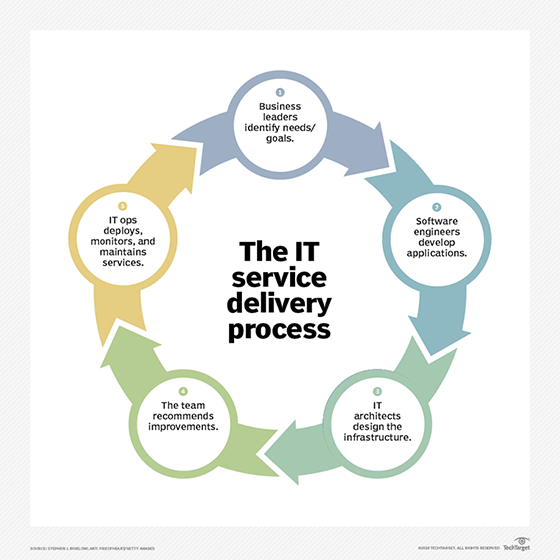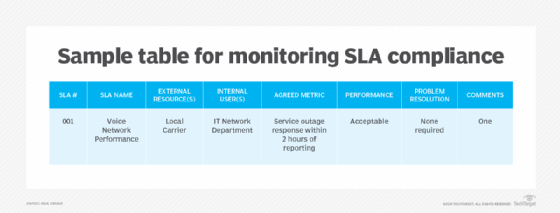IT service delivery
What is IT service delivery?
IT service delivery is the way a corporation provides users access to IT services, such as applications, data storage and other business resources. IT service delivery covers design, development, deployment, operation and retirement. Many IT professionals play a role in the various stages of service delivery. Quality of IT service delivery is gauged by metrics included in a service-level agreement (SLA).
An IT service management (ITSM) framework, such as IT Infrastructure Library (ITIL), dictates the processes, people and products involved in IT service delivery. The IT team enforces both preferred and prohibited approaches in accordance with established regulations, compliance and governance requirements, or best industry practices.

ITIL version 2 had two core sections -- ITIL service support and ITIL service delivery -- both of which fell under the umbrella of ITSM. In the most recent update, ITIL version 4 uses a service value chain with create, deliver and support as tenets.
A formalized system for IT service delivery benefits an organization with large or complex software and hardware deployments, diverse system requirements, dynamic IT configuration changes, high uptime requirements and demanding user expectations. Business units have options outside of the dedicated IT team, including public cloud hosting and software-as-a-service products.
However, part of IT service delivery is ensuring a given product or service meets the data and security control standards of the business. Shadow IT -- when services are procured outside of sanctioned means -- exposes the business to risks.
IT service delivery vs. IT service management
From a practical perspective, IT service delivery is defined almost identically to ITSM. A service is something that provides value to a user. Delivery references a particular focus on service quality to establish an SLA and ensure compliance. Does the IT service provider deliver what the user -- the IT service customer -- expects?
ITSM is the preferred term for how IT service providers operate and continuously improve upon all the services offered. ITSM aims for increased efficiency in delivery of service benefits to the business and its users. ITSM covers every aspect of the service and its creation, while IT service delivery is primarily focused on the end user's ability to use the service. In common usage, this subtle distinction is often blurred.
Aspects of service delivery
IT service delivery encompasses everything needed to run an IT product:
- Service management encompasses defining the service and its support levels. This might include the SLAs, budget, and what the service covers and does not cover.
- Capacity management includes the resources needed to run the service and acquire additional resources as needed. This may require forecasting usage.
- Availability and continuity management includes making sure that the service remains available and planning for what to do in the event of outages.
IT service delivery framework
A service delivery framework (SDF) is a set of guidelines and governance to help an organization design, build and deliver a service. Most SFDs focus on service lifecycle or a value stream approach. The lifecycle includes service planning and strategy, design, transition and operation. Continuous improvement is a key element throughout the service's lifecycle.
ITIL is the most popular IT service delivery framework. Control Objectives for Information and Related Technologies, Microsoft Operations Framework and Federated IT Service Management (FitSM) are examples of other frameworks.
The IT service delivery platform
The products and resources involved in a service's lifecycle are referred to as the IT service delivery platform.
IT service delivery tools, interchangeably referred to as ITSM tools, generally cover diverse functional areas, such as the following:
- The overlapping categories of help desk and service desk.
- Service catalog, which is a collection of services offered to users, sometimes based on role or permissions.
- Knowledge and issue management.
- Configuration management database.
- Workflow management to follow queries and requests from development to delivery.
- Performance and log monitoring to track the behavior and availability of each application and service.
- Key performance indicators to identify a service's current and future behaviors and growth needs.
IT operations and data center personnel also can improve IT service delivery with technologies that provision IT resources faster, such as containers, virtualization and the cloud.
Examples of help desk and service desk tools with diverse IT service delivery capabilities include ServiceNow, BMC Remedy, Cherwell Service Management and Datto Autotask Personal Services Automation.
IT service delivery and SLAs
IT services carry a measurable cost for the business to offer, which encourages the use of a guarantee or promise of a service's performance, availability and uptime. An SLA is the primary method to codify the expectations for a given IT service and detail the relationship between its provider and the customer. For example, a business that requires IT to deliver a service with 99.5% availability permits up to 3.65 hours of downtime per month. Availability goals are generally set to a minimum of 99.5% but often go in excess of 99.9%.

SLAs exist between external, third-party providers and business users. Businesses and users rely on reporting to verify adherence to the SLA's terms or to prove a breach. SLAs can stipulate terms for remediation of a breach of contract, such as payment credits.
An operational-level agreement (OLA) is a contract between groups in an organization. OLAs are like SLAs and may specify the same types of things, like uptime or response guarantee.
An organization can also track return on investment in an IT service, such as whether the service supports digital transformation goals, drives business growth and reduces risk. If it does so, does it do so at an acceptable total cost of ownership?
IT service delivery roles
In some organizations, an IT service delivery manager oversees and improves the ITSM framework and delivery platform, but this task also falls to more expansive titles, such as IT manager and director. IT service delivery is often tied to user satisfaction, business reputation and revenue generation, so IT service delivery is a high priority for the chief information officer, as well as the IT organization. IT operations, first- and second-level support staff, and diverse other roles are involved in service delivery. Developers can also play a part to create or customize services.
Besides technological advances to improve IT service delivery, a corporation can invest in revamping business processes and operations teams to respond proactively to issues and changes throughout an application's lifecycle. For example, if service performance declines due to increased use, the IT service delivery team can identify the issue and work with business leaders to budget and provision additional resources to prevent capacity constraints from hampering the business.
Explore ITIL and DevOps to see what path an enterprise should choose. See how to plan for a successful ITIL implementation. Understand the differences between IT change management vs. configuration management.







